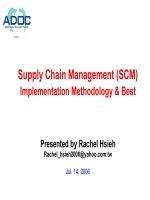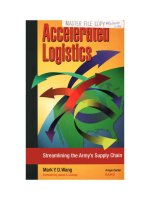Industry’s supply chain model at Crocs MBA6151 unit VI case study
Bạn đang xem bản rút gọn của tài liệu. Xem và tải ngay bản đầy đủ của tài liệu tại đây (92.06 KB, 8 trang )
Running head: INDUSTRY SUPPLY CHAIN MODEL AT CROCS
Industry’s supply chain model at Crocs
Le Viet Anh
Columbia Southern University
1
INDUSTRY SUPPLY CHAIN MODEL AT CROCS
2
Introduction
Crocs, Inc. is one of the world's leading footwear manufacturers with innovative designs
and materials. This brand makes a difference thanks to Croslite, a well-developed system, a
remarkable technological improvement that helps keep their products light, comfortable and
prevent moldy odors. The company has established distribution systems in more than 90
countries around the world with annual sales of about three hundred million pairs of shoes
(About Us, 2017). In this article, I would like to mention the core competencies of this brand,
and then thoroughly analyze their impact and how the company will exploit them in the future to
improve product quality and increase profitability.
Crocs, Inc.'s core competencies
Core competence is sustainable energies that are valuable, rare, costly to imitate and
irreplaceable, which are used as a source of competitive advantage for Crocs over their rivals
(Hitt, Ireland, & Hoskisson, 2016). It distinguishes this company from other competitors in the
industry as a whole and creates its own personality.
From the details mentioned in the explanation of this case we can easily recognize that
Crocs core competencies are relevant and satisfy the criteria outlined in the concept of core
competencies. Firstly, they have a highly responsive supply chain. By establishing relationships
with suppliers in different places, different countries and different material areas, they have the
coordination and rotation of production to ensure the safety of raw material sources. Secondly,
they also maintain flexibility for the unexpected needs of customers. Crocs' top managers are
also very good at quickly recognizing supply chain constraints after examining it. The old supply
chain accepts orders from retailers in January, and start producing orders to meet the market in
INDUSTRY SUPPLY CHAIN MODEL AT CROCS
3
the spring and fall. Product quantity is also produced excess to prepare for the unexpected needs
of customers. However, this supply chain contains many shortcomings because retailers often
have to place orders based on their market forecasts. This will inevitably lead to either overestimation resulting in unsold stock, inventory cost and loss, or over-estimation resulting in
potential profit losses. Instead, Crocs has developed a revolutionary lineage system that enhances
relationships with customers and retailers. This system will respond quickly to fluctuations in
demand of customers. Just like Crocs CEO Ronald Snyder, if a good-seller sells a product, they
will produce it right away and will be back on the shelves after a few weeks. The company will
not wait until next year and expect the existence of that trend (Schroeder, Goldstein, &
Rungtusanatham, 2013). Finally, Crocs has developed an effective distribution model when its
products are found everywhere, across countries and territories. They have become the pioneers
of this product line in those countries. They also participated in many events and exhibitions in
various fields to promote the products to potential customers.
Exploiting core competencies in the future
In order to achieve these core competencies, the company has invested heavily in
infrastructure and supply chain management with new management through three steps: (1)
Further vertical integration in to materials, (2) Growth by Acquisition and (3) Growth by Product
Extension.
First, let's discuss further vertical integration in to materials. Basically, there are two
types of supply chain practices that are Efficient Supply Chain (LEAN) which provides forecasts
based on inventory and Agile supply chains which provides forecasts based on information
(Kotzab, Seuring, Müller, & Reiner, 2006). Crocs understands the dynamics of the
INDUSTRY SUPPLY CHAIN MODEL AT CROCS
4
manufacturing industry they are pursuing and has established an agile network to connect
retailers. Its main objective is to integrate its vertical activities in order to synthesize and provide
an option for input testing and distribution of output products. This agile supply chain has many
features that can be exploited such as market sensitive which is closely connected to end-user
trends; virtually integrated which relies on shared information across all supply chain partners;
network based which gains flexibility by using the strengths of specialist players; and process
aligned which has a high degree of process interconnectivity between the network members.
Next is the information about growth by acquisition. Ronald Snyder realized that
acquisitions played an important role in supporting growth so that he conducted a series of
acquisitions to integrate horizontally and implement the company's strategies. Initially, Crocs
acquired the Canadian manufacturer, Foam Designs also known as Finproject NA, in June 2004.
This acquisition helped Crocs acquire intellectual property rights (IPR) of Croslite, an advanced
technology of materials as mentioned in the introduction. Soon after, Crocs continued to buy
Fury, EXO Italia, and Jibbitz at the end of 2006 and then Ocean Minded, LLC in early 2007 to
refine the product line and its accessories on a variety of materials. Thanks to these acquisitions,
Crocs' products are now diverse in design and types as well as can serve a wide variety of
consumers. In other words, they have satisfied multiple target markets and boosted sales of the
company.
Finally, it is taking advantage of the capacity to grow by product extension. The garment
industry is generally sensitive to product changes. Crocs has done this well to keep its customers
motivated. Beach and Cayman are the traditional products of the company and are the basis for
the development of other footwear products. The company's website introduces more than 30
basic footwear models for all ages and occupations. In addition, the company continues to
INDUSTRY SUPPLY CHAIN MODEL AT CROCS
5
diversify its products in other forms such as cooperating with Disney, developing products for
special audiences, and sponsoring professional sport events. There are a lot of new accessories
coming out such as hats, jackets, socks, pants and backpacks.
How do these alternatives affect Crocs' core competencies?
In order to identify the suitability and impact of each alternative, it is best to analyze their
strengths and weaknesses in the business context in which the company is operating.
Vertical integration has the strengths in meeting the demand for products and large scale
production. It is also an effective barrier to prevent competitors from entering the market with
the ability to control the value chain and negotiating well with suppliers and buyers. At the same
time, it also brings difficulties in balancing production capacity during periods of reduced sales
resulting in surplus products and increasing production costs.
Growth by acquisition plays an important role in accessing and owning development
technologies, and it also reduces competition and replacement risk from new products to better
meet customer expectations. However, it also has weaknesses related to determining the net
present value (NPV) of the acquired company and its concerns about integration, corporate
culture or differences in organizational practices and structures.
Growth by product extension will enable the company to meet the needs of a diverse
range of customers, boosting re-purchase rates. This also makes old products obsolete quickly
and prevents competitors from catching up or copying designs. However, it increases the cost of
production and can cause a lack of coordination between suppliers and retailers in the future.
INDUSTRY SUPPLY CHAIN MODEL AT CROCS
6
Recommendations on production and inventory planning of Crocs
At present, most Crocs’ products are self-produced (in house production) by the
company, which helps to reduce ineffective outsourcing operations. In the future, the company
could focus more on the development of molded shoes and casting products in China due to low
export tax rates in this market. They also need to have an overall assessment of the different
production regions in the world for proper structural shifts both for the short run and long run. In
addition, markets in Europe and the United States have become saturated with their products, so
it is necessary to shift the market to other countries to increase geographical and regional
diversity. Meanwhile, Denver distribution network can be used to distribute other products of
other companies to cover the minimum fixed costs. Crocs has developed a global inventory
planning system to help managers make faster decisions and better manage their inventory as
point-of-sale electronic data is synchronized with the information system of the company. These
information systems can be developed much further in the era of cloud computing. This is the
right direction of technology for the company in the future.
All of the strategic moves that the company's management has done are for the sole
purpose of increasing profits for the company. High profit margins over competitors also directly
impact Crocs' order, production and inventory behaviors. In general, more profitable companies
are more likely to hold more inventories. As shown in Exhibit 4, Crocs has the industry's highest
gross margin of 56.5% and the lowest inventory turnover ratio of 3.5 so it helps the company to
manage production and inventory better because they have more cash and can roll over capital
quickly (Schroeder, Goldstein, & Rungtusanatham, 2013). Each step in the supply chain can be
efficiently satisfied with good support from financial resources.
INDUSTRY SUPPLY CHAIN MODEL AT CROCS
Conclusion
In conclusion, by using a combination of different strategies to link the benefits to the
organization, Crocs has become a prime example of efficient supply chain management. Their
success in management helps companies compete strategically and dominate the market. Crocs'
development is not only reflected in short-term strategies and goals, but they have established
sustainable growth and developed steadily for long-term goals in the future.
7
INDUSTRY SUPPLY CHAIN MODEL AT CROCS
References
About Us. (2017). Retrieved April 4, 2017, from Crocs: />Hitt, M. A., Ireland, R. D., & Hoskisson, R. E. (2016). Strategic Management: Concepts:
Competitiveness and Globalization. Boston, MA: Cengage Learning.
Kotzab, H., Seuring, S., Müller, M., & Reiner, G. (2006). Research Methodologies in Supply
Chain Management. Berlin: Springer Science & Business Media.
Schroeder, R. G., Goldstein, S. M., & Rungtusanatham, M. J. (2013). Operations Management
in the Supply Chain: Decisions and Cases, 6th ed. New York, NY: McGraw-Hill.
8









